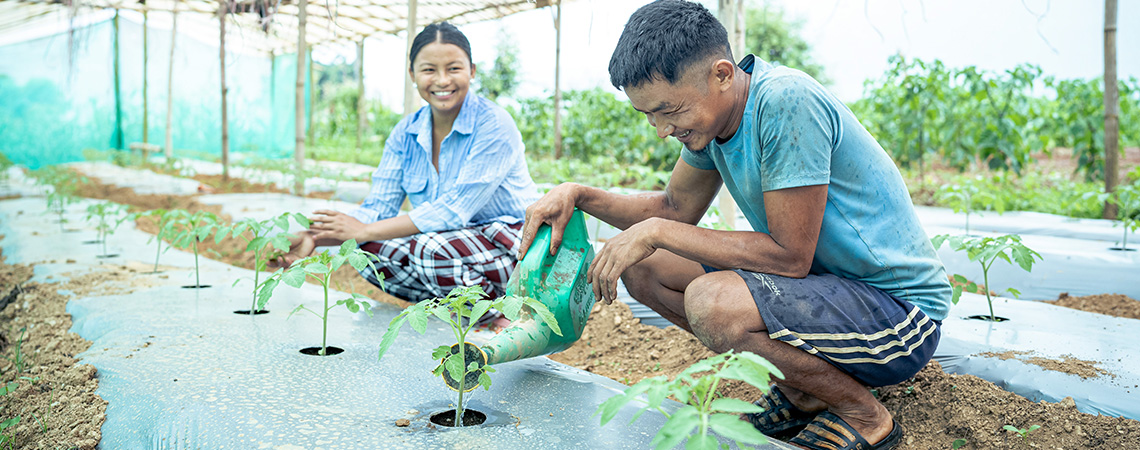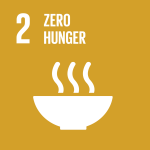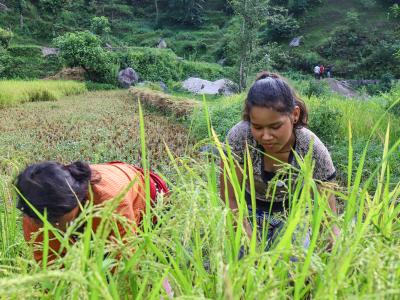
Photo:
In Nepal’s mountain regions, climate change is driving more intense monsoon rainfall and increasing snow and glacial melt rates.
These trends are contributing to more frequent and severe floods and landslides, resulting in extensive damage to agriculture, property, and the environment, thereby disrupting lives and livelihoods and threatening food security. At the same time, water scarcity and droughts are also threatening agriculture-reliant livelihoods.
This project focused on safeguarding vulnerable communities and their assets from climate change-induced disasters by applying a long-term, multi-hazard approach – with a particular stewardship role for women and marginalized communities – focused on Nepal’s watersheds.
Led by the Department of Forests and Soil Conservation, the project focused on two key outcomes:
- Establishing an integrated watershed management framework to address climate change induced floods and droughts; and
- Introducing and scaling-up of integrated watershed management practices in Dudh Koshi, covering 844 square kilometres of watershed areas and benefiting 121,606 vulnerable people.
Key achievements of the project to date include:
- 8 local-level climate-friendly IWM operational directives endorsed and published in local gazette
- 516 water sources protected
- 91 catchment ponds constructed
- 30 km contour trench constructed
- 645 farmers trained on conservation farming
- Drought tolerant NTFPs species cultivated in 201 ha area of land.
- Conservation farming adopted on 650 ha land area.
- 13 multipurpose ponds constructed for the Majhi community
- 106 operational plans of NRM groups revised
- 225 households supported with fuel-efficient improved cooking stoves
- 78,133 people benefitting from water stress management Initiatives
- 11,724 people benefitting from conservation farming/livelihood promotion activities
- Community
- Municipality
- District
- National
- Country Office
- Local Governments
- National Governments
- Non-Governmental Organizations
- United Nations Development Programme (UNDP)
121,606 vulnerable people in Dudh Koshi river basin
- Government of Nepal
- United Nations Development Programme (UNDP)
- Global Environment Facility (GEF)
Expected outcomes
Outcome 1: Integrated watershed management framework has been established to address climate change induced floods and droughts
Output 1.1: Watershed condition assessments updated and hydrometeorological hazard, risk, vulnerability and socio-economic model of climate change impacts delivered to underpin watershed management decisions across the sectors
Output 1.2: Climate change risks addressed in watershed rehabilitation and management framework
Output 1.3: Specialised technical training and technology delivered
Output 1.4: Enforcement mechanisms for watershed management and land policies embedding climate change considerations, including legal incentives to enable PES
Outcome 2: Integrated watershed management practices introduced and scaled up in 1 watershed covering 844 km2 (84,400 ha) of watershed areas and benefiting 121,606 vulnerable people.
Output 2.1: Based on risk and vulnerability assessments, integrated, adaptive sub-watershed management plans developed for four target sub-watersheds to guide investments
Output 2.2: Water and drainage control measures implemented at the sub-catchment level, including water retention structures and catchment ponds with groundwater recharge, controlled drainage and with maintenance systems established
Output 2.3: Watershed rehabilitation, Conservation farming and integrated agro-forestry practices introduced interspersed with fodder and controlled fuel wood production (including efficient stoves) with active involvement of women
Output 2.4: Community stewardship programmes established and implemented within the selected sub-watersheds with focus on women and marginal communities
Output 2.5: Knowledge management and learning
- Image

- Image

- Image

- Image

- Image

- Image

The High Mountain catchments of Nepal are particularly prone to drought, landslides and floods, due to coincidence of seasonal snow melt with the summer monsoon season.
In these highly vulnerable mountain regions warming trends are increasing and the impacts are magnified by the extreme changes in altitude. Around 85% of rainfall occurs during the four monsoon months of June to September and results in extensive flooding annually.
Climate change is intensifying the monsoon rainfall and increasing snow and glacial melt rates, which is contributing to increased frequency and severity of flood and landslide disasters which result in extensive economic, life and livelihood losses annually.
At the other extreme, water scarcity and droughts also pose a threat to the agriculture-reliant livelihoods of these regions. Climate change is increasing the temporal and spatial variability of rainfall and runoff, thus intensifying the problem of excess water during the monsoon and water scarcity during the dry season, increasing economic damages to agriculture, property, and the environment, disrupting lives and livelihoods and threatening food security.
A long-term solution to this climate change problem is to rehabilitate and maintain functional integrity of watersheds that have critical functions of water storage and release, infiltration, drainage control, and soil moisture retention.
Using watersheds as organizing units for planning and implementation of natural resources management and resilient livelihood development is an approach to effectively tackle an immediate and long-term climate risk reduction, in relation to floods and droughts.
Taking watershed management concerns into consideration, this project will embed Integrated Watershed Management approaches in Nepal through policy and practice at the national and sub-national levels.
It will do so through establishing the legislative and institutional framework for integrated watershed management to address climate change induced hazards and introducing and scaling up integrated adaptive watershed management practices covering 844km2 of watershed areas and benefiting 121,606 vulnerable people.
While the project interventions in the legislative and institutional frameworks will be at national and sub-national level, project investment in adaptive management practices will be done within sub-watersheds of the Dudh Koshi river basin which is the most vulnerable to floods and droughts.
‘Project formulation for building climate resilience in vulnerable watershed’, Nature Khabar, November 15, 2017
Outcome 1: Integrated watershed management framework has been established to address climate change induced floods and droughts
Output 1.1: Watershed condition assessments updated and hydrometeorological hazard, risk, vulnerability and socio-economic model of climate change impacts delivered to underpin watershed management decisions across the sectors
Activity 1.1.1: Multi-hazard climate-responsive hydrometeorological hazard, risk and socio-economic vulnerability modelling and mapping methods and tools introduced for floods, landslides, soil erosion and droughts and embedded in IWM procedures
Activity 1.1.2: Existing catchment prioritisation tools harmonised and updated with modelling output from 1.1.1 for use across all IWM-relevant departments and sectors
Activity 1.1.3: Revise watershed condition assessment methodologies and guidelines
Activity 1.1.4: Condition assessment undertaken for target watersheds using new modelling and assessment tools, guidelines and protocols
Activity 1.1.5: Establish project SDI to act as central repository for all data and to facilitate data sharing and single data sources, including mobile app versions.
Output 1.2: Climate change risks addressed in watershed rehabilitation and management framework
Activity 1.2.1: Review institutional arrangements and device necessary institutional coordination for IWM
Activity 1.2.2: Establish centralised IWM coordination platforms, comprised of all relevant institutions, to develop harmonised, overarching IWM policies, guidelines, standards and protocols and to oversee cross- sectoral cooperation on IWM
Activity 1.2.3: Revise national institutional guidelines, standards and data sharing protocols for IWM across all institutions to include, national policy on watershed management, revised harmonised climate-risk based sub-watershed vulnerability assessment, prioritization guidelines, guidelines for GESI mainstreaming in IWM, SoP’s for maintenance of watershed management systems established, revised guidelines for infrastructure, and revised SCWM program.
Activity 1.2.4: Establish institutional framework at local level for IWM to include, as a minimum, sub-national disaster risk management committees (municipality and ward level) and revised guidelines for sub-watershed management planning at local level. Coordination platform at local level across WMOs and municipalities.
Output 1.3: Specialised technical training and technology delivered
Activity 1.3.1: Develop capacity development plan for long-term technical, functional and resourcing capacities for target institutions
Activity 1.3.2: Establish Technical Working Group for IWM in Nepal to include all levels
Activity 1.3.3: Implement training plan across all institutions to include technical training in the use of new climate responsive watershed modelling tools and assessment methodologies, risk assessment, socio-economic risk and vulnerability assessment, CBA, watershed prioritisation tool and the use of new IWM guidelines, standards and protocols.
Activity 1.3.4: Hydrometeorological monitoring equipment purchase, installed and operational within the target watersheds with clear and budgeted O&M plan
Output 1.4: Enforcement mechanisms for watershed management and land policies embedding climate change considerations, including legal incentives to enable PES
Activity 1.4.1: Cross-sectoral working group on PES established to include income generating sectors (hydropower, tourism, forestry), national, and local government institutions
Activity 1.4.2: National overarching PES Policy supported for finalisation
Activity 1.4.3: Policy and institutional arrangements reviewed for PES-like and other (e.g. conservation bonds, grants) climate risk financing mechanisms
Activity 1.4.4: Feasibility study of a broad-range of PES-like and other financing mechanisms completed for target watersheds and develop Watershed Finance Plans
Activity 1.4.5: Guidance for local municipalities on PES-like and other financing mechanisms management practices developed
Activity 1.4.6: Establishment of community maintenance groups, their SoP and the necessary mechanisms of all types of structural systems being implemented by the project.
Outcome 2: Integrated watershed management practices introduced and scaled up in 1 watershed covering 844 km2 (84,400 ha) of watershed areas and benefiting 121,606 vulnerable people.
Output 2.1: Based on risk and vulnerability assessments, integrated, adaptive sub-watershed management plans developed for four target sub-watersheds to guide investments
Activity 2.1.1: Baseline data updated from 9 wards out of 42 wards of 3 Municipalities and 5 Rural Municipalities (Dudh Koshi WS), baseline data for up to 9 control group. Therefore, baseline data will be collected for to 18 wards.
Activity 2.1.2: Develop Integrated Watershed Management Plans for the target watersheds and sub-watersheds. Four integrated sub-watershed management plans will be operational on pilot scale in Dudh Koshi watershed area focusing on three thematic areas Drought, Flood and Landslides.
Output 2.2: Water and drainage control measures implemented at the sub-catchment level, including water retention structures and catchment ponds with groundwater recharge, controlled drainage and with maintenance systems established
Activity 2.2.1: Detailed designs of multi-purpose water retention/conservation structures (catchment ponds with contour trench, water holes, community ponds with gravity feed to users,); construct water retention structures; Establish community-based water management systems to improve water regime, as per the integrated sub-watershed management plan.
Activity 2.2.2: Water sources protection including wells and springs rehabilitated.
Output 2.3: Watershed rehabilitation, Conservation farming and integrated agro-forestry practices introduced interspersed with fodder and controlled fuel wood production (including efficient stoves) with active involvement of women
Activity 2.3.1: Land productivity enhancement measures – conservation farming (including integrated pest management, integrated farming systems, fodder production, agroforestry, greenery and animal husbandry).
Activity 2.3.2: Functional water use/reuse systems - (rain water harvesting, household roof to root water harvesting (for soil water retention). Micro-irrigation technology such as solar powered water lifting to hillslope communities, used-water collection pond/tank) and drought resistant crop variety[1] promoted.
Activity 2.3.3: Farmers education/training on conservation farming and agroforestry (including home gardening, agro-biodiversity conservation, contour plantation) and supported with gender friendly, labour efficient agriculture tools.
Activity 2.3.4: Traditional watershed friendly practices promoted (Specifically for Majhi community multi-purpose water ponds will also be fish farms), Pocket area for drought tolerant NTFP species identified and cultivated. Shrubland provided to the poor on long term lease to practice agro-silvipastoral system.
Activity 2.3.5: Technical assistance to develop capacity to construct fuel efficient stoves as a payable service provision.
Activity 2.3.6: Reforestation of degraded watershed slopes using seed bombing.
Output 2.4: Community stewardship programmes established and implemented within the selected sub-watersheds with focus on women and marginal communities
Activity 2.4.1: Strengthening of existing NRM groups (including community forestry groups, lease hold forestry groups, farmers groups, animal husbandry groups, water user groups, community development/watershed management groups) and new groups formed to engage them in project implementation for sustainability of land management measures.
Activity 2.4.2: Network of NRM groups will be established and strengthened. Training delivered to forestry groups, water user groups, water resource user groups
Activity 2.4.3: Operational plan of NRMs groups (specifically community forestry and leasehold forestry groups) will be revised with the provisions for soil and water conservation and watershed management.
Activity 2.4.4: Strengthen existing groups /cooperatives and develop new groups, as needed, as rural finance institutions to support farmers for productive works (linked with livelihoods activities under 2.3). Agricultural cooperatives, Savings and credit cooperative.
Output 2.5: Knowledge Management and Learning
Activity 2.5.1: Connecting people to Information and knowledge
The project will build on the foundation of previous knowledge. New knowledge gained on the project will be captured and stored appropriately for others to access and learn from, including:
At least 5 case studies will be generated per year of the project
Rapid Evidence review – Project Preparation stage studies have established the project baseline which will be updated throughout the project as it progresses and published in various technical and nontechnical documents.
Knowledge Banks (web databases) – The project will develop a knowledge and data management website for all project, stakeholder and beneficiary staff
Activity 2.5.2: Connecting people to people
The following series of tools and techniques describe how knowledge management will enable people to connect to people more effectively.
Community of Practice (CoP/Knowledge network/professional network) – The project will set up a number of technical working groups, at all necessary levels to enable practitioners (CoP) to interact and share experiences
Peer Assist – The project will engage a range of local and international experts who will provide technical assistance to the project. For long-term peer assist, the project will help establish relationships between institutions and local as well as international universities and research centres
Knowledge café – This will be achieved through the meetings of the technical working groups and through bi-lateral meetings between individual stakeholder organisations
Knowledge marketplace – This will be provided by project experts who will be identifiable by their area of expertise and will provide support to the project and stakeholders. In the long-term, a ‘directory’ of experts can be developed to fill this need.
Activity 2.5.3: Institutional KM improvement
Summarizing lessons learnt and experiences and sharing them with others can help build and retain knowledge. The following series of tools and techniques describe how the project knowledge management will enable improvement through impact assessments, evaluations and people management.
Gone well/not gone well - All significant project events/activities will be subject to a debrief to capture good/bad points and lessons learned
After Action review (AAR) formative evaluation - All significant project events/activities will include formal minutes which will be made available on project portal
Retrospective review (summarise evaluation) - A formal project lessons learned document will be available for all project staff to complete (managed by PM) online
Knowledge Exchange and embedding KM tools and practices - All project staff will have as final deliverable a summary report to include knowledge transfer information and other lessons learned. In addition, all knowledge products generated within the project including technical reports, methodological guidelines, regulatory and policy, planning and outreach materials will be available on-line, and all project knowledge products and documents will be collected and archived on e-library on multi-hazard disaster risk management
Impact Evaluation – Establish Impact evaluation framework. Assess project impact on physical and financial assets, impact on Social Capital, Empowerment and change of behavior, Impact on Food Security, Environmental Impact, Impact on Institutions, policies, and the regulatory framework, Impact on Gender.
Inception workshop, June/July 2020
The project will be monitored annually and evaluated periodically during project implementation, in line with UNDP requirements as outlined in the UNDP POPP and UNDP Evaluation Policy.
While the National Project Manager is responsible for day-to-day project management and regular monitoring of project results and risks, including social and environmental risks, the Project Board will hold project reviews to assess the performance of the project and appraise the Annual Work Plan for the following year. In the project’s final year, the Project Board will hold an end-of-project review to capture lessons learned and discuss opportunities for scaling up and to highlight project results and lessons learned with relevant audiences.
The Implementing Partner is responsible for providing all required information and data necessary for timely, comprehensive and evidence-based project reporting, including results and financial data, as necessary. The Implementing Partner will strive to ensure project-level M&E is undertaken by national institutes and is aligned with national systems so that the data used and generated by the project supports national systems.
The UNDP Country Office will support the National Project Manager as needed, including through annual supervision missions, and is responsible for complying with all UNDP project-level M&E requirements as outlined in the UNDP POPP.
The project will produce:
· An initial inception workshop and report*
· Annual GEF project implementation reports
· An independent mid-term review
· An independent terminal evaluation, to be made publicly available in English on the UNDP Evaluation Resource Centre
· A final report package consisting of the project’s terminal project implementation report, as well as the terminal evaluation report and corresponding management response
*Other M&E activities deemed necessary to support project-level adaptive management will be agreed during the Project Inception Workshop and will be detailed in the Inception Report.
Results from the project will be disseminated within and beyond the project intervention area through existing information sharing networks and forums. The project will identify and participate in scientific, policy-based and/or any other networks, which may be of benefit to the project.
The project will share lessons learned that might be beneficial to the design and implementation of similar projects, with continuous information exchange between this project and other projects of similar focus in the same country, region and globally.
The UNDP Country Office will retain all M&E records for this project for up to seven years after project financial closure.
- UNDPKeti ChachibaiaRegional Technical Advisor, Climate Change Adaptation









